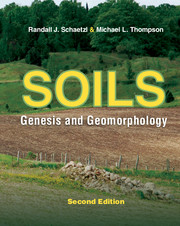10 - Soil Parent Materials
Published online by Cambridge University Press: 12 January 2024
Summary
The influence of parent materials on soil properties has long been recognized. Early pedologists and soil geographers based their taxonomic concepts of soils largely on their presumed parent material. Later, parent material became viewed as simply one of five factors that influence soil development – an influence that diminishes in importance with time. Parent material provides the framework for the developing soil profile and, to a large extent, determines the limited array of soils that can possibly form at a place (Fig. 10.1). In fact, the more holistically a soil is examined, including the many deep horizons below the upper meter or two, the more important parent material seems.
One goal of soil geomorphology is to identify the types and origins of a soil's parent material, because such knowledge helps to explain the evolution of the soil and the landform on which it has developed. Soil genesis studies must almost always ascertain the origin and characteristics of the parent material. This is particularly true for soils on Pleistocene or younger surfaces (Roy et al. 1967, Schaetzl et al. 2000). Many times, the role of the soil geomorphologist is to produce a surficial geology map from a soil map (Fig. 8.9). From this surficial sediment map a better understanding of the past sedimentological and surficial processes that were operative across this landscape is possible. Such an exercise may be relatively easy for young soils on young landscapes, but it is an extreme challenge on older landscapes. Indeed, making a soil survey is nearly impossible without detailed information about surficial geology, illustrating the interrelatedness of soils and parent materials in almost all landscapes.
At least two potential problems may arise when trying to identify the parent material of a soil. First, it may have been highly weathered and altered prior to the current period of pedogenesis. In many such cases, the parent material is actually a previous soil and the soil is, by definition, polygenetic, e.g., Waltman et al. (1990) (see Chapter 13). Second, the soil may be formed in more than one parent material, as either discrete or intimately mixed layers, e.g., Frolking et al. (1983) or Rabenhorst and Wilding (1986a), some of which may be so thin that pedogenesis and pedoturbation have blurred them.
- Type
- Chapter
- Information
- SoilsGenesis and Geomorphology, pp. 181 - 231Publisher: Cambridge University PressPrint publication year: 2015



